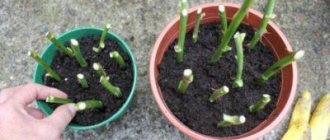The best varieties of indoor peonies
To grow peonies at home, you need to give preference to miniature plants. Their height should be:
- not less than 20 cm;
- no more than 45 cm;
- on average 30-35 cm.
These flowers have a rich aroma. Their root system is adapted for small pots.
London
Peony London is a representative of the variety of the Patio Peony series. Features of the variety:
- will delight flower growers with attractive, densely double flowers;
- the flowers are distinguished by a pinkish-red hue;
- The buds have a pleasant aroma.
Moscow
This variety is considered the best for patio planting. Peony Features:
- has beautiful ruby-red flowers that emit a light aroma;
- The peculiarity of the flower is that the base of the petals is darker than the edges, which creates a slight gradient effect;
- The color of the petals does not fade.
An early variety with beautiful flowers, which are distinguished by a pink tint with a scarlet tint and a yellow center. Features of the variety:
- the plant is perennial;
- the flowers have a sweet aroma;
- This peony is an excellent choice for a potted garden due to its compact growth and abundant flowering.
This variety is classified as low-growing peonies. Peculiarities:
- the bush is compact, height is 35 cm;
- pink and lilac petals look excellent;
- Patio peonies are widely used as a potted plant that serves as decoration for terraces, balconies and patios.
Zhu Sha Pan
A great house plant. Features of the variety:
- grows in length and width from 0.6 to 0.75 m;
- experienced flower growers consider this variety to be the best for growing plants at home;
- unpretentious and does not require special conditions of detention.
Features of planting at different times of the year
Healthy and intact suction roots are the key to successful establishment of young plants
To determine how to plant peonies and when to do it, you need to have an idea of the characteristics of their root system.
- Its central, most massive part serves as a kind of storehouse for nutrients. It is this that supports the plant during wintering and protects it from the cold.
- Thinner processes extend from it. The density and abundance of flowering bushes depend on their condition, since replacement buds and young stems are formed on these roots. Sprouts in the form of light, thin root shoots are formed in the fall, in September.
- Another important part of the root system is the suction shoots, which can be thought of as a thin web that collects micronutrients and moisture. To avoid damaging it, when planting peonies it is necessary to prepare a wide and deep hole.
To choose the right moment when you can replant peony bushes, you need to know the peculiarities of crop adaptation at different times of the year.
in spring
Transplanting peonies in spring has one significant drawback: it is easy to be late with this work.
With the end of winter, the plants wake up. There is a rapid growth of suction roots. If you start replanting the bush during this period, these roots can be damaged, which threatens the death of the entire plant. It will not receive nutrition and will quickly use up the reserve that has accumulated in the massive central roots.
Important! Bushes that have been transplanted in the spring often become overgrown with a thick green mass. But next winter they do not survive, since over the summer their storehouse of useful substances is used up, and there are not enough of them for the winter
If you still replant the bushes after wintering, then this should be done as early as possible, immediately after the snow cover melts, before the plants awaken. By this time, the roots do not have time to wake up. They begin to develop in a new area.
In summer
In June and July, the crop actively grows green mass, and the suction roots have time to grow and gain a foothold in the soil in the spring. Their development slows down, but the roots actively extract moisture and nutrients. When buds form on the bushes, the main forces of the plant are directed to the flowers.
If you replant peonies in the summer, the suction roots will inevitably be damaged and the nutrition of the bushes will deteriorate. In the new area, neither the development of new roots nor the adaptation of old ones occurs. The only source of nutrition is the reserves already made by the plants. But there are not enough of them for wintering, which often leads to the death of peonies.
According to statistics, most bushes transplanted in summer wither within a month
in autumn
In autumn, peonies stop blooming and begin to prepare for winter. The green mass is not growing. Plants store nutrients. Their absorbent roots actively extract nutrients and grow quickly. This period is considered the best time to plant peonies. The bushes are ready to be divided and moved to a new site. The roots are ready for the winter cold.
One month is enough for the culture to take root normally. Before frost sets in, peonies have time to grow suction roots. In the northern regions, planting can be done as early as mid-August. In the middle zone, the optimal time is in September, and in the south it lasts until mid-October.
Note! When replanting bushes in the fall, it is important not to be late. On average, at the end of September there begins a period of active growth of storage roots, where plants retain a supply of necessary elements. They become denser and more voluminous
Transplantation must be carried out before this time, otherwise the bush will not survive the winter.
They become denser and more voluminous. Transplantation must be carried out before this time, otherwise the bush will not survive the winter.
On average, at the end of September there begins a period of active growth of storage roots, where plants retain a supply of necessary elements. They become denser and more voluminous. The transplant must be carried out before this time, otherwise the bush will not survive the winter.
Preparing for landing
Due to their excellent lush forms and enchanting aroma, peonies are considered to be the flowers of kings. Many gardeners want to grow these flowers in their apartment.
This can be done correctly only by following the recommendations of experts:
- Having purchased a plant, you need to pay special attention to its preservation.
- Planting is carried out only with the appearance of the first buds. Until this period, it must be kept in the refrigerator, which will ensure good flower growth.
- Decorative peony needs to be planted following a set of measures. Before planting, the planting container must be filled with nutrient soil (up to half).
- A nutrient mixture should be added to the voids. Form a surface peat layer.
Landing rules
The most favorable time for planting plants is the beginning of spring. To plant home peonies, you need to choose flower pots with a volume of at least 5 liters and a diameter of 25 centimeters. The optimal height of the planting container should be 45 centimeters.
Peonies can be planted not only in classic flower containers or pots. Wooden boxes, the inner surface of which is covered with dense non-woven material, are also quite suitable for this.
When making your own soil mixture, you need to mix river sand, humus, peat and garden soil. To this composition you need to add a small amount of bone meal, ash and superphosphate.
For planting, you need to select shoots from the root system of those plants whose age does not exceed 3 years. Planting material can be planted only after the first buds appear. Until this point, the shoots should be stored in the refrigerator.
List of basic activities that will help to properly plant a decorative peony:
- choosing a flower container;
- formation of a drainage layer, which may consist of fine pebbles, broken bricks and perlite (layer 3–5 centimeters);
- covering the pebbles with coarse sand (but not river sand!);
- filling the planting container to the middle with nutrient soil;
- placing selected roots on the ground, the buds of which should be directed upward;
- filling all voids with a nutrient mixture;
- formation of a surface peat layer;
- abundant soil moisture.
This flower has a negative attitude towards frequent transplants. Experts recommend not using very small planting containers for planting.
If all planting rules are followed, the plant will be able to form buds within a few months.
Choosing soil and pot for your home
Gardeners recommend using a soil mixture with peat added to fill the pots. Planting should be done in a container that has a drainage layer. This eliminates stagnation of moisture, which can lead to rotting of the roots.
You can make your own soil mixture by mixing the following components:
This composition requires components such as ash and superphosphate.
You need to select a pot based on the growth of the flower. It is worth taking into account that the plant requires a lot of space. The best option would be a pot with a diameter of 50-60 centimeters and a depth of 30-40 cm. If the species is large, then an even larger volume will be needed. It is also worth making sure that there are holes at the bottom of the container. The best option is 5 liter pots.
Features of caring for tree peonies in pots
- You should select spacious (up to 25-30 liters), thick-walled containers made of decorative ceramics, in which plants can be kept for 5-6 years without replanting. Containers made of wood or stone with outlet holes for good water drainage are also suitable. Pots made from these materials look visually good and reliably protect the earthen ball around the roots from overheating.
- It is also possible to plant peonies in plastic flowerpots, but in order to protect the roots from excessive fluctuations in ambient temperature, you need to dig them deeper into the soil, approximately equal to the surface of the soil in the garden.
- Hydrogel (3-4 spoons), initially added to the potting soil mixture, will also help protect plants from rapid drying out. After all, the soil in the container dries out quite quickly.
- It is advisable to apply fertilizers diluted with water and in reduced concentration. The soil balance in the local space of the container is easily disturbed if plant feeding is done incorrectly, “by eye”. In this case, the risk of excessive stimulation of root growth cannot be excluded.
- For plants in pots, foliar feeding once a month is well suited.
- It is preferable to water from below, pouring water into the pan.
- 65% topsoil and 35% perlite will ensure sufficient soil looseness and good drainage.
- Adult (5-6 year old) plants can be divided and planted in prepared containers.
How to plant and grow seedlings
Flower growers with many years of experience recommend planting shoots that are no more than three years old. Planting material can be planted as soon as the first buds appear.
How to do it right:
- Place the tuber perpendicular to the moist soil. When choosing a position, you want the buds to grow upward.
- It should be borne in mind that the flower has a negative attitude towards constant transplants. For this reason, small planting containers cannot be used.
- To check the recommended depth (2.5-5 cm), place the tuber at the top of the soil mixture. Compliance with this parameter is considered a priority when planting, as it will ensure the flowering of peonies.
- After determining this indicator, you need to mix water with the mixture so that it becomes wet.
- To ensure that the soil receives the right amount of nutrients before planting, you need to add compost. You can also use special organics.
- In the spring, fertilizer with a low nitrogen content should be added to the soil. You can purchase fertilizers in specialized stores.
Caring for a plant at home
Experts note that the plant can be grown strong if favorable conditions for its growth are created. To grow a flower at home, it is important to competently approach issues related to watering and lighting.
Observe the following rules:
- A flower requires sufficient sunlight to grow.
- The best option for placing pots is on the south and east sides of the window sill. This will provide the flower with light for twelve hours.
- When installing plants in a place with unsatisfactory lighting, gardeners recommend providing sources of artificial light. You need to connect special timers to them. With their help, the lights will be automatically turned on in the morning and turned off in the evening.
- It is necessary to place fluorescent lamps 20 cm above the flower. They must operate 14 hours a day.
Adviсe
When placing a plant you need to remember:
- the flower does not grow well if there are strong wind currents;
- also, the plant should not be installed near heating devices;
- the flower should be moistened as it dries;
- gardeners recommend pouring water evenly until it flows out through the drainage holes. It is especially necessary to reduce watering in early autumn and reduce lighting;
- in order for the flower to adapt to the dormant period, it is necessary to reduce the temperature;
- flower growers warn that peony should not be sprayed, as it does not tolerate high humidity;
- gardeners with many years of experience recommend placing containers with flowers on glazed balconies in the summer.
Due to the deep planting of the tuber, there is a rapid increase in green mass, but there are no buds. When watering a flower, it is necessary to prevent water from entering, which can cause fungal diseases and dangerous pests.
Pruning and feeding
Fertilizing should be done during the budding period using potassium. Two weeks after the peony begins to bloom, minerals must be added to the soil: potassium and phosphorus. This fertilization system must be followed every year.
In late autumn, you need to trim the above-ground part of the plant. You need to place the pot in a dark and cool place. You can get plants from these places with the onset of spring. In this case, it is necessary to moisten the soil well enough.
What conditions must be observed when caring for decorative peony?
For good growth and lush flowering, perennials need suitable conditions.
Pay attention to the following points:
- temperature;
- watering, humidity level;
- lighting;
- application of fertilizers.
Temperature
In a very warm room, peony root formation stops. Recovers at a temperature of 10-15 °C. The plant overwinters at 5-8 °C.
Watering and humidity
Water the perennial with water at room temperature when the soil surface is dry to 1.5-2 cm. The liquid is distributed over the entire surface of the container; the flowers cannot tolerate excessive watering. The remaining moisture should exit through the drainage hole. At the end of summer, the frequency of watering is reduced: wait until the soil in the container dries completely, then only moisten the soil.
Note! The flower does not tolerate spraying or droplets falling on the leaves and petals.
Lighting
For the development of inflorescences, select the brightest place for peonies in the apartment. The south side of the room works well. It is not always possible to find a sufficiently illuminated place; in this case, peony lovers will be helped out by an LED phytolamp. The light spectrum ensures active growth. The device can be brought fairly close to the leaves; the LED has a low voltage, which increases its safety when water gets on the body. The time for using artificial lighting is reduced at the end of August, as preparations for the dormant period begin during this month.
Feeding
When the first stems appear, the soil begins to be fertilized. Feed the plant once every 30 days. For this purpose, prepared mixtures for perennial flowers are used; fertilizing stops at the beginning of autumn. Ash and sand are used as protection against mold; ready-made fertilizers with nitrogen are selected in flower shops. During the ripening period of the buds, potassium and phosphorus are added to the soil. When the shoots reach 10 cm in height, fertilize once every 14 days.
How to care for a peony in winter
In winter, reduce the frequency of watering. Place the pot in a cooler and less lit place. They do this in order not to provoke the beginning of the growing season. The flower is left dormant for the winter.
Is it possible to grow on a balcony?
The balcony is a great place to grow peonies. The flower will delight you if you follow all the tips regarding its growth.
To do this, optimal conditions should be provided:
- If the flower grows slowly in the spring, nitrogen-potassium fertilizers must be added to the soil. They help stimulate growth.
- If you notice that the flower is withered, you should install fluorescent lamps. They will supplement the lack of light, which will stimulate plant growth.
- Flower growers say that peonies can be grown on the balcony in winter. To protect the flower from freezing, it should be covered with material that retains heat.
With proper care of the flower, you can enjoy its flowering for a long time without cutting off the side buds. The flowers will be large. When they are cut, the flowering period increases to three weeks. After budding is completed, all stems must be trimmed. Fertilizing should be done with the addition of potassium and phosphorus. Due to these minerals, the shrub will delight gardeners with large buds. With the onset of autumn, the flower must rest. For this purpose, it can be moved from the balcony to a cool place, for example, to a cellar or garage. As soon as the new season arrives, the plant can be put back in its original place.
Varieties for home cultivation
One of the key points is the choice of flower variety. Some varieties are quite bulky, so they are unlikely to be comfortable in a narrow pot. Experienced gardeners recommend the following varieties:
- Rome - this variety of indoor peonies, growing in a pot, produces lush pink flowers with a diameter of up to 10 cm. It is low-growing, has a dark green leaf color. It blooms in early summer and has a delicate aroma.
- Moscow - belongs to the low-growing series, plant height is about 25 cm. The leaves are medium-sized, dark and elastic. The flower is fiery red, with yellow stamens in the center. Grows up to 6 cm, exuding a delicate aroma.
- Oslo - the bush can reach 55 cm. At the beginning of summer, the peony will delight you with crimson flowers with a yellow center. The variety is quite frost-resistant and unpretentious in care. Does not like frequent and abundant watering.
- London – maximum plant size – 60cm. This type of peony pleases the eye with pink and red hues. The flowers reach 16 cm. The leaves are sparse and small.
How to prepare a peony for planting
The plant is quite controversial. It has a number of features that need to be taken into account when growing indoor peonies in a pot.
- Appropriate place. In order for the flower to bloom magnificently and delight the hostess, it is necessary to take care of a good “foundation”. It does not tolerate stagnant moisture and constant shadow. Using peat as a fertilizer is undesirable, because the capricious handsome man does not like it.
- The soil. The best environment for peonies grown at home in a spacious pot is drained and cultivated soil. It needs to be prepared two weeks before planting. It is necessary to plant only in loose soil, otherwise the roots will be deformed and the plant will not be able to receive nutrients. To prevent rot, you can sprinkle a little sand and ash on top of the soil.
- Seedling. Some housewives think that if you plant an adult seedling, the plant will immediately delight you with flowers. This is a mistake; most likely, the bush will die due to old age in two years. For perennial flowering, it is better to choose a young seedling.
- Depth - from the top bud to the surface of the ground should be left from 3 to 7 cm. If the soil type is heavy, then 4 cm is better.
Is it possible to transplant an indoor peony outside?
To transplant into open ground, indoor peonies must undergo preparation. In autumn, seedlings are placed in a pot, observing dormant conditions. At the beginning of spring, the plant is added dropwise along with the container. At the end of August they are transferred to the ground.
Peonies remain dormant for 3 months before planting in the garden plot.
Lush bright red or soft pink peony buds can please the eye not only in the garden. The plant is easy to plant and grow, you just need to create the conditions necessary for its development.
The necessary conditions
To get lush blooming peonies in your own apartment and grow a healthy bush, it should be as comfortable as possible. If the flower was planted improperly, the shoots will form weak. In this case, flowering may not occur.
Basic conditions that must be observed when growing peony at home:
- Wide and spacious pot.
- Compliance with light conditions.
- Proper watering and regular fertilizing.
To make the lush plant comfortable, you need to choose a pot of at least 5 liters. If you don’t want to plant it in a pot, you can replace it with a box. Whatever container is chosen, it is worth making drainage holes. Excess moisture that the flower does not need escapes through them.
Planting process step by step
To grow special varieties of peonies at home yourself, you need to know the sequence of actions. Indoor varieties of peonies must be planted in the spring. Landing instructions:
- The bottom of the container must be laid with a drainage layer. To do this, you can take pebbles or pieces of brick. Sand is poured on top.
- The pot needs to be filled halfway. The filler is a mixture of garden soil and peat. Moisten with water.
- Set the rhizome on top of the soil. Sprinkle it with 2-3 cm of soil. If you cover it too much, the plant will not develop.
- Fill the pot with the rest of the mixture.
- Feed with fertilizer and water generously.
The plant does not tolerate numerous transplants. It is necessary to immediately select a wide container to minimize the number of further manipulations.
How to save peonies before planting in spring
If the desire to purchase a peony rhizome of the desired variety at an attractive price turned out to be stronger than the reasonable decision to wait with the purchase until the right time, nothing terrible happened. Peonies can be saved at home and planted in the garden when the time comes.
First, you need to inspect the planting material. If rotten areas or other damage are found on the root of the plant, they must be cut out with a clean knife.
The cut areas are treated with a raspberry solution of potassium permanganate or brilliant green, or a solution of any fungicide.
If the peony rhizomes are in a dormant state, thin young roots are not visible on them and the growth buds have not yet awakened, the peony can be stored in the refrigerator. The herbaceous peony is wrapped in slightly damp moss or a flannel cloth dipped in a solution of phytosporin or plain water.
Then the root is put into a bag (not the one in which the plant was sold!). You must make holes in the bag with an awl for air circulation.
Further care and possible difficulties
To find out whether it is possible to grow peonies on the balcony, it is worth studying the characteristics of this plant. After proper planting, it is desirable that the peony quickly takes root and begins to grow. To do this, you need to organize proper care.
- Location. The peony should receive a lot of light and should be placed on a bright windowsill. If there is not enough lighting, you should illuminate it with a fluorescent lamp.
- Watering. The plant needs regular watering. The signal for the next watering is the drying of the top layer of soil. At the end of summer it is worth reducing the amount of water. Spraying is not required for the peony; it does not like humidity.
- Fertilizer. Peonies require very little time and labor to grow well at home. Every housewife wants to grow such a beauty in a pot. This flower consumes many useful substances. The soil is depleted at lightning speed, so you need to feed the flower.
Such manipulations are performed in three stages:
- To stimulate growth, use nitrogen-potassium fertilizers.
- During the budding period, phosphorus or potassium should be given.
- Repeated application of phosphorus occurs after two weeks.
When growing this flower you may encounter the following difficulties:
- Lack of flowering and limp bushes. This happens due to lack of lighting.
- In spring, the peony is lazy and does not grow. It is worth stimulating it a little with nitrogen.
- The plant does not form new shoots. To save it, you need to transplant it into another pot.
- There is no need to water the flower too much, otherwise parasites will appear. A humid environment stimulates the development of fungus.
To grow beautiful peonies in pots for home decoration yourself, you need to follow the recommendations given above. These simple techniques will allow you to grow lush flowers right on the balcony and enjoy their view.











